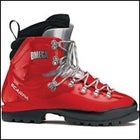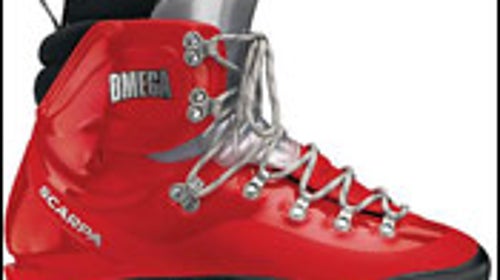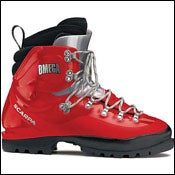Whats good to have are boots designed for ice climbing. Whats good to avoid are boots that, well, arent. Hows that for advice?
Scarpa Omega ice boots
 Omega ice-climbing boots
Omega ice-climbing bootsOf course, nothing is quite that simple. And a lot depends on what you mean by ice climbing.” For travel across icy glaciers and slopes up to 45 degrees, for instance, you often can get by just fine with mid-weight mountaineering boots. A good example of that: La Sportivas Glacier EVO ($250; www.sportiva.com), an updated version of that long popular climbing/heavy backpacking boot. The Glacier has beefy 2.8mm leather, a half-steel shank, and a nylon midsolea little flex for hiking, but plenty of support for cramponing. And theyll fit in most automatic” (strapless) crampons.
You can even do some front-pointing of the glaciers (that is, facing the ice and kicking your toe points into it). But if thats your idea of ice climbingand I gather that it isthen you need a real ice-climbing boot. Scarpas Omega boots ($369; www.scarpa.com) are just the ticket, with a light but very stiff carbon-fiber midsole and plastic shell. Theyre an extremely rigid boot. Kick in a front point, and theyll hold as long as you choose to stay there.
But they are kind of pricey. Scarpas venerable Inverno ($279) offers surprising technical capabilities in a comfortable, all-around plastic boot that can take you up peaks such as Rainier, while still giving you enough boot for the occasional waterfall climb.
I hope youll let your dad help you out with some techniques and advice. Dont hesitate to look for a local climbing club as wellno doubt you can find one with regular trips to locales such as the North Shore of Lake Superior, which has cold temps and some good ice routes.
Be safe!
Check out this years more than 400 must-have gear items, including , in the 2006 Buyers Guide.


